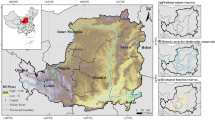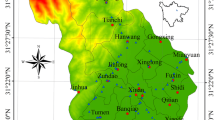Abstract
Understanding the trade-off between the loss of ecological lands and farmland to urbanisation could alleviate negative consequences to the environment and food security. This study aims to analyse the impact of urbanisation on ecological lands and farmland by comparing respective losses of habitat quality and agricultural productivity potential. Different scenarios are established indicating the priority of conserving ecological lands or farmland based on their vulnerability as measured by weight. With a land-use simulation model LANDSCAPE, the demand for urban land is met by occupying inferior ecological lands or farmland. Land-use patterns in each scenario are projected to 2035 in Wuhan (a rapidly urbanising city in China). As the weight of habitat quality decreases, the loss of habitat quality increases from 2.56 to 5.80%, while the loss of agricultural productivity potential decreases from 4.16 to 2.94%. The higher vulnerability of habitat quality loss indicates that ecological lands need a priori conservation than farmland in exchange for urbanisation.





Similar content being viewed by others
References
Bekessy S, White M, Gordon A, Moilanen A, Mccarthy M, Wintle B (2012) Transparent planning for biodiversity and development in the urban fringe. Landsc Urban Plan 108(2-4):140–149
Berry P, Garlick J, Smith R (2007) Near-global validation of the SRTM DEM using satellite radar altimetry. Remote Sens. Environ 106(1):17–27
Brady R, Terry T, Eagles P, Ohrner R, Micak J, Veale B, Dorney R (1979) A typology for the urban ecosystem and its relationship to large biogeographical landscape units. Urban Ecol 4:11–28
Burley J (1989) Multi-model habitat suitability index analysis in the Red River Valley. Landsc Urban Plan 17(3):261–280
Burley J (1995) International greenways: a Red River Valley case study. Landsc Urban Plan 33:95–210.
Burley J (1996) Designing to preserve wildlife. Landsc Des 9(10):16–23
Burley J, Wang Y, Loures L (2009) New ecologies: Emergence of the Urban Savanna and Cliff Detritus in a Post-modern Era. In: Panagopoulos T (Ed.) New models for innovative management and urban dynamics. University of Algarve, Faro, Portugal
Chen J (2007) Rapid urbanization in China: a real challenge to soil protection and food security. Catena 69(1):1–15
Cho S, Poudyal N, Lambert D (2008) Estimating spatially varying effects of urban growth boundaries on land development and land value. Land Use Policy, 25(3):320–329
d’Amour C, Reitsma F, Baiocchi G, Barthel S, Güneralp B, Erb K, Seto K (2017) Future urban land expansion and implications for global croplands. Proc Natl Acad Sci 114(34):8939–8944
Deng X, Huang J, Rozelle S, Zhang J, Li Z (2015) Impact of urbanization on cultivated land changes in China. Land Use Policy 45:1–7
Deng J (1989) Introduction to grey system theory. J Grey Syst 1(1):1–24
Dieleman H (2015) Urban agriculture in Mexico City: balancing between ecological, economic, social and symbolic value. Journal of Cleaner Production S156–S163
Ekroos J, Olsson O, Rundlöf M, Wätzold F, Smith H (2014) Optimizing agri-environment schemes for biodiversity, ecosystem services or both? Biol Conserv 172:65–71
Frenkel A (2004) The potential effect of national growth-management policy on urban sprawl and the depletion of open spaces and farmland. Land Use Policy 21(4):357–369
Grimm N, Faeth S, Golubiewski N, Redman C, Wu J, Bai X, Briggs J (2008) Global change and the ecology of cities. Science 319(5864):756–760
Guzy, M, Smith, C, Bolte, J, Hulse, D, & Gregory, S (2008). Policy research using agent-based modeling to assess future impacts of urban expansion into farmlands and forests. Ecol Soc 13(1):37
Godfray H, Charles J et al. (2010) Food Security: the challenge of feeding 9 billion people. Science 327:812–818
Hubei Bureau of Statistics (2016). http://tjj.hubei.gov.cn/
Huang Q, Wang R, Ren Z, Li J, Zhang H (2007) Regional ecological security assessment based on long periods of ecological footprint analysis. Resour, Conserv Recycling 51(1):24–41
Ke X, van Vliet J, Zhou T, Verburg P, Zheng W, Liu X (2018) Direct and indirect loss of natural habitat due to built-up area expansion: A model-based analysis for the city of Wuhan, China. Land Use Policy 74:231–239
Ke X, Zheng W, Zhou T, Liu X (2017) A CA-based land system change model: LANDSCAPE. Int J Geographical Inf Sci 31(9):1798–1817
Kennedy C, Hawthorne P, Miteva D, Baumgarten L, Sochi K, Matsumoto M, Evans J, Polasky S, Hamel P, Vieira E, Develey P, Sekercioglu C, Davidson A, Uhlhorn E, Kiesecker J (2016) Optimizing land use decision-making to sustain Brazilian agricultural profits, biodiversity and ecosystem services. Biol Conserv 204:221–230
Lin B, Liu H (2015) China’s building energy efficiency and urbanization. Energy Build 86:356–365
Liu J, Zhang G, Zhuang Z, Cheng Q, Gao Y, Chen T, Chen D (2017) A new perspective for urban development boundary delineation based on SLEUTH-InVEST model. Habitat Int 70:13–23
Liu L, Xu X, Chen X (2015) Assessing the impact of urban expansion on potential crop yield in China during 1990–2010. Food Security 7(1):33–43
Liu S, Du W, Su H, Wang S, Guan Q (2018) Quantifying impacts of land-use/cover change on urban vegetation gross primary production: A case study of Wuhan, China. Sustainability 10(3):714
Liu X, Li X, Shi X, Zhang X, Chen Y (2010) Simulating land-use dynamics under planning policies by integrating artificial immune systems with cellular automata. Int J Geographical Inf Sci 24:783–802
Mitsova D, Shuster W, Wang X (2011) A cellular automata model of land cover change to integrate urban growth with open space conservation. Landsc Urban Plan 99:141–153
National Bureau of Statistics of China (2016). http://www.stats.gov.cn/english/
Newton P, Baum S, Bhatia S, et al. (2001) Human settlements: Australia state of the environment report. Human Settlements – Australia, 2002:v-189.
Peng J, Yang Y, Liu Y, Du Y, Meersmans J, Qiu S (2018) Linking ecosystem services and circuit theory to identify ecological security patterns. Sci Total Environ 644:781–790
Pryor R (1968) Defining the Rural-Urban Fringe. Oxford Journal 47(2):202–215
Rykiel Jr EJ (1996) Testing ecological models: the meaning of validation. Ecol Model 90(3):229–244
Schneider A, Logan K, Kucharik C (2012) Impacts of urbanization on ecosystem goods and services in the US Corn Belt. Ecosystems 15(4):519–541
Seto K, Fragkias M, Güneralp B, Reilly M (2011) A meta-analysis of global urban land expansion. PloS ONE 6(8):e23777
Sharp R, Tallis H, Ricketts T, Guerry A, Wood S, Chaplin-Kramer R, ... Vigerstol K (2015). InVEST version 3.2. 0 User’s Guide. The Natural Capital lProject
Shen L, Cheng S, Gunson A, Wan H (2005) Urbanization, sustainability and the utilization of energy and mineral resources in China. Cities 22(4):287–302
Singh R (Ed.) (2015) Urban development challenges, risks and resilience in Asian mega cities. Springer, Tokyo
Song W, Pijanowski B (2014) The effects of China’s cultivated land balance program on potential land productivity at a national scale. Appl Geogr 46:158–170
Tan M, Li X, Xie H, Lu C (2005) Urban land expansion and arable land loss in China—a case study of Beijing–Tianjin–Hebei region. Land Use Policy 22(3):187–196
United Nations, 2012. https://population.un.org/wup/
van Vliet J (2019) Direct and indirect loss of natural area from urban expansion. Nat Sustainability 2:755–763
van Vliet J, Bregt A, Hagen-Zanker A (2011) Revisiting Kappa to account for change in the accuracy assessment of land-use change models. Ecol Model 222(8):1367–1375
van Vliet J, Naus N, van Lammeren R, Bregt A, Hurkens J, van Delden H (2013) Measuring the neighbourhood effect to calibrate land use models. Computers, Environ Urban Syst 41:55–64
Visser H, de Nijs T (2006) The map comparison kit. Environ Model Softw 21(3):346–358
Wang Y, Li X, Zhang Q, Li J, Zhou X (2018) Projections of future land use changes: multiple scenarios-based impacts analysis on ecosystem services for Wuhan city, China. Ecol Indic 94:430–445
Wehrwein G (1942) The rural-urban fringe. Clark University 16(3):217–228
White R, Engelen G (1997) Cellular automata as the basis of integrated dynamic regional modelling. Environ Plan B: Plan Des 24:235–246
Wuhan Natural Resources Management and Planning Bureau (2011). http://gtghj.wuhan.gov.cn/
Xu L, Huang Q, Ding D, Mei M, Qin H (2018) Modelling urban expansion guided by land ecological suitability: a case study of Changzhou City, China. Habitat Int 75:12–24
Yankson P, Gough K (1999) The environmental impact of rapid urbanization in the peri-urban area of Accra, Ghana. Geografisk Tidsskr-Dan J Geogr 99(1):89–100
Yang, X, Zou, J, Kong, D, & Jiang, G (2018). The analysis of GM (1, 1) grey model to predict the incidence trend of typhoid and paratyphoid fevers in Wuhan City, China. Medicine, 97(34).
Zhou W, He J (2013) Generalized GM (1,1) model and its application in forecasting of fuel production. Appl Math Model 37(9):6234–6243
Author information
Authors and Affiliations
Corresponding author
Ethics declarations
Conflict of Interest
The authors declare that they have no conflict of interest.
Additional information
Publisher’s note Springer Nature remains neutral with regard to jurisdictional claims in published maps and institutional affiliations.
Appendix
Rights and permissions
About this article
Cite this article
Zhou, T., Ke, X. Which Should be Conserved According to Priority During Urban Expansion? Ecological Lands or Farmland?. Environmental Management 67, 81–90 (2021). https://doi.org/10.1007/s00267-020-01385-3
Received:
Accepted:
Published:
Issue Date:
DOI: https://doi.org/10.1007/s00267-020-01385-3




